Papers by Andrew Williams

Accountability is a much studied subject in the social sciences and is known for its complexity, ... more Accountability is a much studied subject in the social sciences and is known for its complexity, context dependence, and ambiguity. By conducting a comprehensive literature review and analysis across nonprofit, public, and private sector literatures, this article identifies the causes of ambiguities present in many accountability frameworks and describes the trend toward understanding accountability as a constructed concept combining both instrumental and interpretive elements. The relationship between legitimacy and accountability is considered. The authors develop a holistic accountability framework that facilitates defining and implementing accountability in complex, multi-stakeholder environments, by providing a means to operationalize commonly encountered but ambiguous accountability goals through a social process of deliberative dialogue. The authors conclude by summarizing limitations of the approach and describing future research needed. Résumé La responsabilisation est un sujet abondamment e ´tudié dans les sciences sociales, et connue pour sa complexité, sa dépendance contextuelle et son ambi-guı¨té. Par la conduite d'une e ´tude et d'une analyse exhaustives a ` travers les publications des secteurs sans but lucratif, public et privé, cet article s'attache a ` identifier les causes des ambiguı¨tés présentes au sein de nombreux cadres de re-sponsabilisation. Il décrit la tendance en faveur d'une compréhension de la re-sponsabilisation en tant que concept construit associant tant des e ´léments instrumentaux qu'interprétatifs. La relation entre légitimité et responsabilisation fait l'objet d'une e ´tude. Les auteurs développent un cadre holistique de responsabili-sation facilitant la définition et la mise en oeuvre de cette dernière dans des
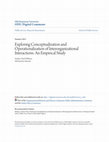
This dissertation reviews the approaches to conceptualization and operationalization of interorga... more This dissertation reviews the approaches to conceptualization and operationalization of interorganizational interaction in the public administration literature. While many frameworks, typologies and arrays have been offered, few have been tested empirically. Furthermore, the literature incorporates a widely stated but untested notion that interactions between organizations can be placed on a “continuum” of intensity or integration. Using insights from previously developed systems-based frameworks and arrays, this research creates a generalized interorganizational interaction array (GIIA) that conceptualizes and operationalizes three forms of interaction common in public administration literature: cooperation, coordination and collaboration. From a sample of over 200 interorganizational interactions between national and international defense organizations, the GIIA is tested using cluster analysis to determine: the extent to which collaboration, coordination and cooperation are observed; which variables are most important in differentiating interaction states, and to explore the concept of a continuum of interaction. Results show the only interaction state clearly observed is collaboration in about half of sample cases; the remaining cases cannot be easily classified as either cooperation or coordination. Only variables relating to collective decision making structures and processes are essential for identifying collaboration, but are not useful in distinguishing between cooperation or coordination. Variables relating to the context or situation have little influence on differentiating interaction states, and variables describing properties of the organizations such as trust, autonomy and shared perspectives have more ability to distinguish outcomes rather than form. Finally, the concept of a continuum of interaction is not supported. The implications of this finding for future conceptualization and operationalization and development of theory is considered.

Military weapons and equipment benefit a great deal from advances in technology. These advances h... more Military weapons and equipment benefit a great deal from advances in technology. These advances have allowed combatants to engage targets more accurately and from further away, which has meant increased safety for military forces and civilians and an improved capability to accomplish assigned tasks. The latest technology to improve the capability of military systems is autonomy. Military systems are gaining an increased capability to perform assigned tasks autonomously, and this capability will only improve over time. Autonomy in military systems allows human operators to remain out of harm’s way and to complete tasks that manned systems cannot (or to complete these tasks more efficiently. If autonomous capability achieves the potential that many of its supporters believe it can, this will radically change how military operations are conducted. Because these changes may be so significant, and because they allow systems to perform tasks without being constrained or guided by constant human oversight, autonomous technology needs to be examined from an ethical perspective. This is especially necessary because autonomous capability can have both negative and positive effects on human life. While many articles and chapters focus exclusively on either the negative or positive implication of autonomous systems, this chapter considers both and offers recommendations for advancing policy in a manner that takes into account ethical considerations for the development and use of autonomous systems.
Drawing from the findings of a collaborative project between several nations and NATO Allied Comm... more Drawing from the findings of a collaborative project between several nations and NATO Allied Command Transformation, this document offers policy guidance to senior leadership in government defence organisations, industry, and academia. The guidance aims to facilitate planning and preparation for the design, procurement and operation of systems with autonomous capabilities, and to realise the impressive benefits while avoiding potential challenges. The document covers the implications of the definitions for autonomous systems; key legal issues regarding weaponized systems with autonomous capability; ethical, human factors and military concerns; and gives guidance for future research and capability development.
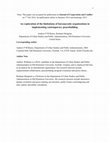
Journal of Cooperation and Conflict
This article seeks to unpack the implications of contemporary peacebuilding for technocratic, bur... more This article seeks to unpack the implications of contemporary peacebuilding for technocratic, bureaucratic organizational forms. It argues that if the contemporary peacebuilding literature is taken as given, fundamental alterations are required in predominately Western peacebuilding systems—specifically in the structure and function of bureaucratic organizations that typically fund, manage and execute peacebuilding interventions. The analysis proceeds by matching five “peacebuilding principles” derived from contemporary literature, with an organizational framework that highlights key structural and functional aspects of bureaucracies, thus allowing organizational deficiencies to be identified. The article argues that current peacebuilding scholarship would benefit from theoretically guided organizational research on the various organizations and systems involved in peacebuilding implementation. It concludes that peacebuilding scholars can be informed by the significant body of knowledge in the fields of public administration and policy, which bring a rich history of studying implementation situations that parallel in many ways complex peacebuilding interventions.
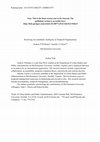
Accountability is a much studied subject in the social sciences and is known for its complexity, ... more Accountability is a much studied subject in the social sciences and is known for its complexity, context dependence, and ambiguity. By conducting a comprehensive literature review and analysis across nonprofit, public, and private sector literatures, this article identifies the causes of ambiguities present in many accountability frameworks and describes the trend toward understanding accountability as a constructed concept combining both instrumental and interpretive elements. The relationship between legitimacy and accountability is considered. The authors develop a holistic accountability framework that facilitates defining and implementing accountability in complex, multi-stakeholder environments, by providing a means to operationalize commonly encountered but ambiguous accountability goals through a social process of deliberative dialogue. The authors conclude by summarizing limitations of the approach and describing future research needed.

"Recent experiences in the Balkans, Iraq and Afghanistan have demonstrated that these complex cha... more "Recent experiences in the Balkans, Iraq and Afghanistan have demonstrated that these complex challenges cannot be resolved exclusively by military intervention, and are of such scale that no single agency, government or international organisation can manage them alone. A broad, international consensus has emerged that recognises the importance of coherent and simultaneous application of military, political, economic and civil instruments – known as ‘comprehensive approach’ – to resolve crisis situations. However, efforts to implement comprehensive approaches have been fraught with political and administrative challenges, and have suffered due to conceptual ambiguity in the understanding of collective endeavours.
By analysing research on command and control, organisational science and public administration, a multi-dimensional model is proposed that can assist military, governmental and non-governmental agency leaders in understanding the practical details of interagency interoperability when working in collective endeavours. The NATO Network Enabled Capability interaction maturity model is extended, in order to understand the actual implications of increasing levels of cooperation on organisational structures and operational practices, in cross-organisational collective efforts. The implications of increasing interagency interoperability are thus revealed"
The use of theory-driven evaluation is an emerging practice in the military—an aspect generally u... more The use of theory-driven evaluation is an emerging practice in the military—an aspect generally unknown in the civilian evaluation community. First developed during the 1991 Gulf War and applied in both the Balkans and Afghanistan, these techniques are now being examined in the North Atlantic Treaty Organisation (NATO) as a means to evaluate the effects of military operations in complex, asymmetric conflict environments. In spite of these practices, theory-driven evaluation in the military is still in the developmental stages. This article traces the development to date of theory-driven evaluation in NATO and assesses its strengths and weaknesses in the military context. We conclude that a cross-pollination of ideas between military and civilian evaluators is urgently needed to improve the quality and effectiveness of military evaluation.
Books by Andrew Williams
This volume covers the subject of autonomous systems, which stand potentially to transform the wa... more This volume covers the subject of autonomous systems, which stand potentially to transform the way in which warfare is conducted. Advances in sensors, robotics and computing are permitting the development of a whole new class of systems, which offer a wide range of military benefits including the ability to operate without personnel on board the platform, novel human-machine teaming concepts, and “swarm” operating methods. With any such transformation advances, there are unique operational, legal, ethical and design issues. In a unique multidisciplinary contribution, this volume considers the opportunities, implications and challenges of increasing autonomy in defence systems.
Innovation in Capability Development Publication Series
This book covers the concepts and processes used to measure the progress and results of military ... more This book covers the concepts and processes used to measure the progress and results of military operations—called "Operations Assessment" in NATO. In the past two decades, NATO operations assessment has undergone substantial development, driven partly by the experience of the international missions in Bosnia, Kosovo, Iraq, and Afghanistan. This volume reviews recent practices, and suggests ways the process could be improved, including potential future innovations and capability developments.
Conference Presentations by Andrew Williams
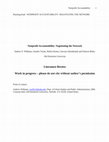
The concept of accountability in the nonprofit and public sectors has received significant attent... more The concept of accountability in the nonprofit and public sectors has received significant attention in both research and practice, partly because of its importance, but also because it is challenging to define, measure and implement. The nature of accountability is complex, ambiguous and highly context-dependent. This paper provides an exegesis of the literature on accountability in the public, private and nonprofit sectors, and develops a holistic accountability framework that facilitates defining, measuring and implementing accountability in complex operating environments impacted by network governance arrangements, multiple stakeholders and the growth of transnational governance and a global civil society. An example of a nonprofit organization in the field of international development is used to illustrate how the holistic accountability framework can be used by senior management and policy makers for the purposes of developing an accountability strategy. A research agenda is proposed to increase the fidelity of the framework to understand the implications for managerial practice and to understand how the increasing prevalence of networked action in the global public sphere affects specific accountability mechanisms.
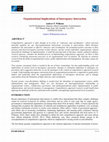
Symposium on Effective Inter-agency Interactions and Governance in Comprehensive Approaches to Operations (HFM-236), Apr 7, 2014
Comprehensive approach is often thought of in terms of “coherence and coordination,” which repres... more Comprehensive approach is often thought of in terms of “coherence and coordination,” which represent desirable qualities for any interorganizational interactions occurring in interventions. Much literature emphasises the antecedents to effective coherence and coordination, the postulated positive outcomes in their presence and observed negative outcomes in their absence, and the various individual, organizational, cultural and political challenges in implementation. A small but growing body of literature, mainly confined to defence research agencies, considers the detailed process of implementing comprehensive approach, yet there is little research considering interaction processes at an organizational level of analysis. By drawing on extensive research from the fields of organizational science, public administration and management, this paper argues for two points.
First, greater conceptual clarity is needed in the use of basic terminology, but also understanding of the real implications of various levels of interagency interaction. Attempts to systematize definitions in typologies are presented, and a suggestion about how to use the typologies in the context of comprehensive approach research is made. Understanding interagency interaction from an organizational perspective is important to guide policy makers and leadership about the organizational implications of interagency interaction, and to manage expectations about the limitations of high coherence and coordination.
Second, greater cross-disciplinary thinking is needed from the disciplines of organizational science, public administration and management. There are vast literatures on interorganizational relationships in organizational science, collaborative governance and multiorganizational policy implementation in public administration, and network dynamics in management. Comprehensive approach research would benefit from applying the multitude of theories and frameworks available, and applying organizational levels of analysis.
Uploads
Papers by Andrew Williams
By analysing research on command and control, organisational science and public administration, a multi-dimensional model is proposed that can assist military, governmental and non-governmental agency leaders in understanding the practical details of interagency interoperability when working in collective endeavours. The NATO Network Enabled Capability interaction maturity model is extended, in order to understand the actual implications of increasing levels of cooperation on organisational structures and operational practices, in cross-organisational collective efforts. The implications of increasing interagency interoperability are thus revealed"
Books by Andrew Williams
Conference Presentations by Andrew Williams
First, greater conceptual clarity is needed in the use of basic terminology, but also understanding of the real implications of various levels of interagency interaction. Attempts to systematize definitions in typologies are presented, and a suggestion about how to use the typologies in the context of comprehensive approach research is made. Understanding interagency interaction from an organizational perspective is important to guide policy makers and leadership about the organizational implications of interagency interaction, and to manage expectations about the limitations of high coherence and coordination.
Second, greater cross-disciplinary thinking is needed from the disciplines of organizational science, public administration and management. There are vast literatures on interorganizational relationships in organizational science, collaborative governance and multiorganizational policy implementation in public administration, and network dynamics in management. Comprehensive approach research would benefit from applying the multitude of theories and frameworks available, and applying organizational levels of analysis.
By analysing research on command and control, organisational science and public administration, a multi-dimensional model is proposed that can assist military, governmental and non-governmental agency leaders in understanding the practical details of interagency interoperability when working in collective endeavours. The NATO Network Enabled Capability interaction maturity model is extended, in order to understand the actual implications of increasing levels of cooperation on organisational structures and operational practices, in cross-organisational collective efforts. The implications of increasing interagency interoperability are thus revealed"
First, greater conceptual clarity is needed in the use of basic terminology, but also understanding of the real implications of various levels of interagency interaction. Attempts to systematize definitions in typologies are presented, and a suggestion about how to use the typologies in the context of comprehensive approach research is made. Understanding interagency interaction from an organizational perspective is important to guide policy makers and leadership about the organizational implications of interagency interaction, and to manage expectations about the limitations of high coherence and coordination.
Second, greater cross-disciplinary thinking is needed from the disciplines of organizational science, public administration and management. There are vast literatures on interorganizational relationships in organizational science, collaborative governance and multiorganizational policy implementation in public administration, and network dynamics in management. Comprehensive approach research would benefit from applying the multitude of theories and frameworks available, and applying organizational levels of analysis.